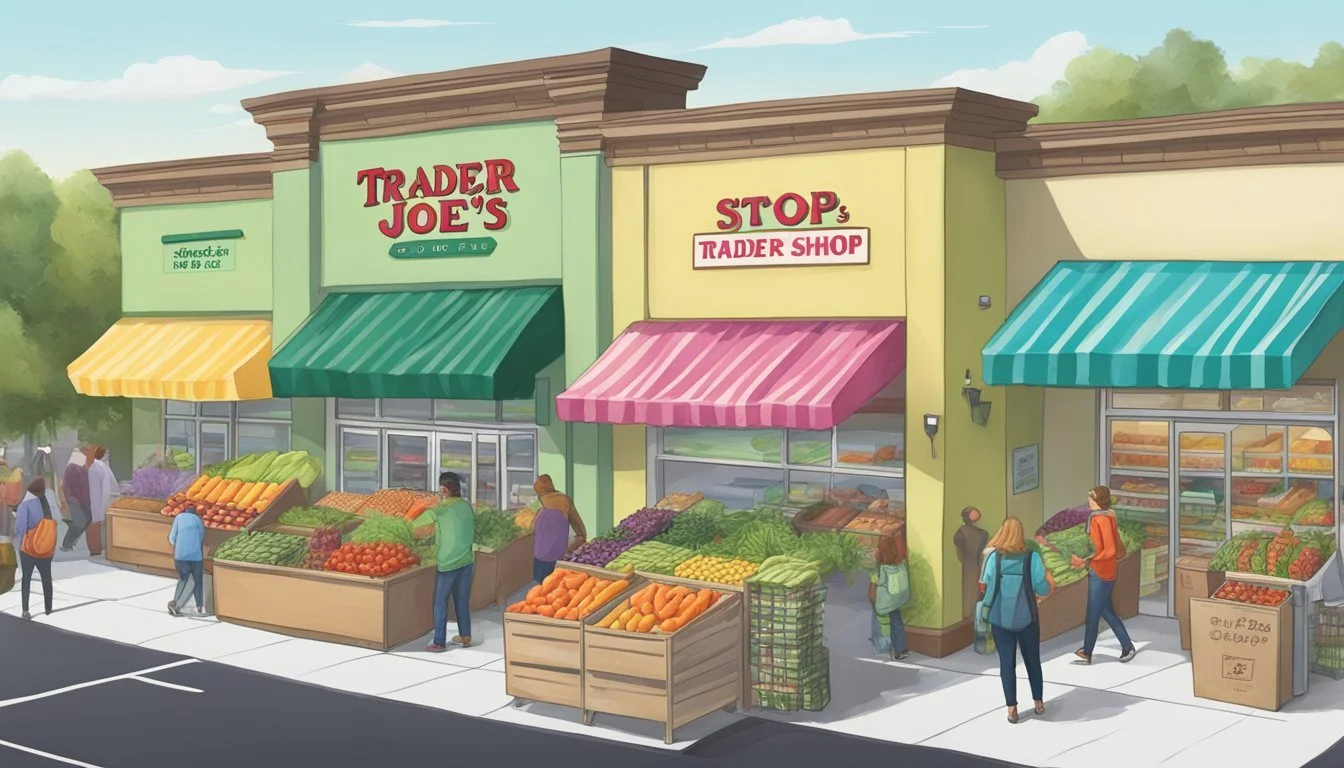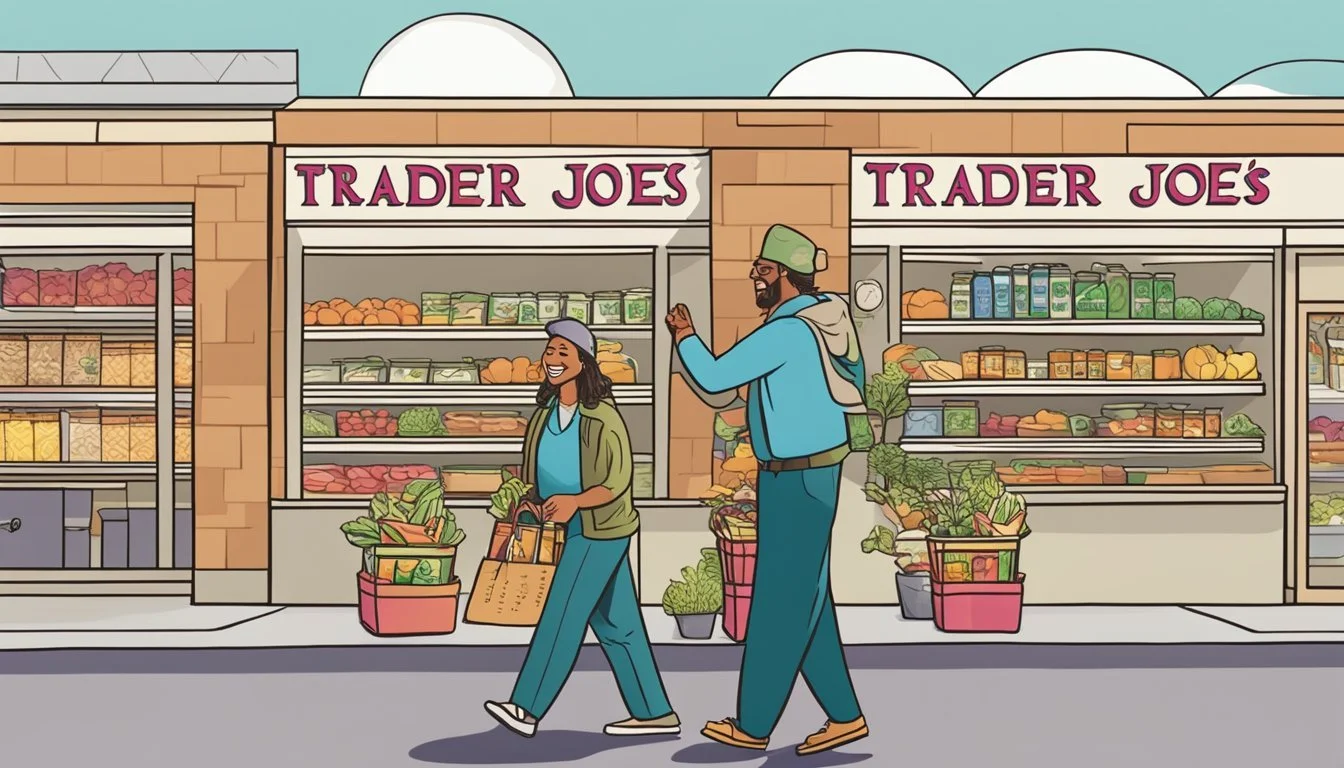Trader Joe's vs Stop & Shop
A Comparative Guide to Your Best Grocery Choice
Part of Our Grocery Store Guide with Details on Trader Joe's and Stop & Shop
Choosing between grocery stores often comes down to a comparison of variety, quality, and pricing. Trader Joe's and Stop & Shop are two major players in the grocery market that offer distinct shopping experiences for customers. Trader Joe's, with its array of private label goods that often lean toward the gourmet, provides a unique selection that includes affordable fancy cheeses, wines, and various artisan snacks. On the other hand, Stop & Shop offers a wider range of national brands alongside its store-brand items, catering to a traditional grocery shopping experience.
When assessing the economic aspect of shopping for groceries, price comparisons have shown that Trader Joe's typically offers lower prices for similar store-brand products compared to Stop & Shop. For shoppers focused on budget, this might tilt the scales in favor of Trader Joe's. However, the preference could vary for shoppers valuing a broader array of products or those loyal to specific national brands, domains where Stop & Shop holds its ground.
The layout and scale of the stores also contribute to consumer preference. Trader Joe's stores are smaller in size with about 4,000 products mostly under its own brand name, which some shoppers find more navigable and convenient. Stop & Shop, with a larger footprint and an extensive product lineup, might appeal to those looking for a one-stop shop for all their grocery needs, including a wide selection of organic and specialty items. Each grocery store tailors to different customer needs, therefore the decision on which is better is often subject to individual shopping priorities.
History and Philosophy
Trader Joe's began as a small chain of convenience stores in 1958. Today, it stands out with its unique shopping experience characterized by a selection of organic and private label products that often cultivates a cult following. The company's philosophy focuses on high-quality items at low prices, and its commitment to providing a joyful shopping atmosphere is evidenced by its friendly crew members and nautical-themed stores.
On the other hand, Stop & Shop has been serving communities since 1914. It has grown from a single corner grocery store into a chain that values customer satisfaction and community engagement. Stop & Shop places emphasis on convenience and delivering a wide range of options, including a generous selection of organic choices to meet the diverse needs of its customers.
Aspect Trader Joe's Stop & Shop Founded 1958 1914 Focus Unique products, joy in shopping Customer satisfaction, convenience Organic Options Yes, with a focus on private label Wide range, including name brands Philosophy High-quality at low prices Community engagement
Both stores aim to provide excellent value and experience to their shoppers, albeit with different approaches. Trader Joe's prides itself on its carefully curated product lines that foster loyalty among customers, while Stop & Shop aims to be the go-to neighborhood store that caters to the day-to-day needs of the local community.
Store Layout and Design
Trader Joe's boasts a distinctive store layout that is typically around 10,000 to 15,000 square feet, significantly smaller than traditional grocery stores. Despite its size, Trader Joe's shopping experience is carefully curated to emulate a familiar grocery shopping pattern. Shoppers usually start on the right, greeted by fresh flowers and produce, with milk at the very back, promoting a complete store journey.
In contrast, Stop & Shop offers a more conventional supermarket layout. The stores are larger, providing a wider selection but potentially making customer navigation more complex. Stop & Shop does not uniformly adhere to a specific layout strategy, and store design may vary by location.
Energy-efficient lighting is becoming a staple in modern grocery store design, yet Trader Joe's and Stop & Shop approach it differently. Trader Joe's smaller store footprint naturally requires less lighting, which may contribute to a more energy-efficient design. Stop & Shop, being larger, has a greater capacity for implementing energy-efficient lighting but may face higher costs due to the bigger space.
Both stores aim to enhance their customers' shopping experience, whether through Trader Joe's strategic store design that influences buyer behavior or Stop & Shop's commitment to variety and traditional store layout. They create environments that align with their brand identities and meet customer expectations.
Product Range and Availability
Trader Joe's and Stop & Shop offer a diverse array of products catering to the needs of different customers. From private label products to organic offerings and dietary-specific foods, these grocery stores ensure a comprehensive product range with a focus on freshness and quality.
Private Label Products
Trader Joe's is renowned for its wide range of private label products, which often boast unique flavors, such as the popular Unexpected Cheddar Cheese. Stop & Shop also offers a plethora of store-brand products, providing cost-effective options for everyday staples.
Organic and Natural Options
Both stores have a commitment to organic and natural products, with Trader Joe's offering a variety of organic options free from pesticides, like organic 2% milk. Stop & Shop also provides an abundant selection of organic goods to meet the demands of health-conscious shoppers.
Special Diet Accommodations
Catering to various dietary needs, Trader Joe's stocks gluten-free, dairy-free, and vegetarian alternatives, making it easier for customers to find suitable products. Stop & Shop similarly accommodates special diets, offering an array of appropriate ingredients and staples.
Meat and Poultry
Meat and poultry options abound at both retailers. Trader Joe's presents marinated meats alongside prime cuts of beef and pork, while Stop & Shop features a range of chicken, steak, and turkey options, including prime selections.
Produce Selection
Trader Joe's is known for its fresh produce, with popular items like bananas, strawberries, and avocados. Stop & Shop competes with a vast assortment of fresh vegetables and fruits, ensuring customers have access to fresh ingredients daily.
Dairy and Eggs
Shelves at both stores are stocked with an assortment of milk, cheese, and eggs, including organic choices such as brown eggs and cream cheese. The range of dairy products at both Trader Joe's and Stop & Shop is tailored to meet customer preferences and needs.
Bakery and Dry Goods
The bakery section at Trader Joe's offers a selection of artisanal breads, while Stop & Shop provides a mix of bakery items and extensive dry goods like cereal, pasta, spices, and seeds.
Frozen Foods and Ready Meals
Trader Joe's frozen section is stocked with quick options, including prepackaged meals and pizza. Stop & Shop also offers a comparable selection of frozen foods and ready meals, giving customers convenient cooking solutions.
Snacks and Beverages
A variety of snacks, like peanut butter, and drinks are available at both grocery stores. Trader Joe's especially shines with its unique snack offerings, while Stop & Shop has a broad range that satisfies all snacking preferences.
Alcohol and Speciality Products
Trader Joe's provides a curated selection of wine and beer, along with specialty cheeses and olive oil. Stop & Shop counters with its own array of alcoholic beverages and gourmet items, ensuring customers can find those special extra touches for any meal or occasion.
Pricing and Value for Money
When comparing Trader Joe's and Stop & Shop, it becomes evident that pricing plays a pivotal role in determining value for money. Trader Joe’s often outperforms with lower prices on a range of items. For instance, when analyzing a list of nearly 50 essential products, Trader Joe's exhibits clear cost benefits, with a total expense of only $150.32, contrasted against Stop & Shop’s higher tally.
In a separate assessment involving multiple grocery stores, price totals demonstrated the competitive edge of Trader Joe’s. Here's a breakdown of the findings:
Grocery Store Total Cost Stop & Shop $12.51 Whole Foods $12.55 Trader Joe's $11.95 Fairway $17.91
Trader Joe's not only maintains low prices but also couples them with high-quality goods, resonating well with consumers on a budget seeking value. Similarly, bulk purchase comparisons highlight the economical options available at Trader Joe's. For example, their 15-ounce box of cereal is notably less expensive per ounce compared to Walmart’s larger pack, emphasizing savings for cost-conscious shoppers.
These price checks point to Trader Joe's as a savvy choice for those who prioritize both reasonable prices and quality. It merits mention that while price is paramount for many, the unique offerings at Trader Joe's may not directly compare with Stop & Shop’s selection, which could alter a shopper's value perception based on individual needs and preferences.
Store Brands vs Name Brands
When shoppers decide between store brands and name brands, they often weigh two critical aspects: quality and pricing. Each has its strengths and can offer value to consumers in different ways.
Quality of Store Brands
Store brands, also known as private label products, have made significant strides in quality, often matching or exceeding their name-brand counterparts. Retailers like Trader Joe's, Whole Foods, Aldi, Walmart, Target, and Amazon have invested heavily in their private labels, ensuring that their packaging and advertising reflect this elevated standard. Middlemen are typically cut out of the process, which can lead to improved quality control. It is a common misconception that store brands are always of lower quality; however, they frequently adhere to the same manufacturing standards as name brands.
Pricing of Name Brands
Name brands typically come with a higher price tag, which can be attributed to factors like advertising and promotional campaigns. These costs are customarily passed on to the consumer. For example, when comparing Stop & Shop's store brands to the nationally recognized alternatives, the name brands often cost more. This pricing difference is partially because name brands usually invest more in packaging and marketing efforts. Contrastingly, store brands save on these expenses, allowing for lower retail prices and potential savings for shoppers.
Customer Service and Shopping Experience
When comparing customer service between Trader Joe's and Stop & Shop, they both prioritize customer satisfaction but follow different approaches. Trader Joe's is renowned for its friendly and engaging staff. They foster a relaxed environment where shoppers feel at ease, unique to the brand's culture. Their staff is often praised for being personable and knowledgeable, which contributes to a positive overall experience.
Stop & Shop, on the other hand, focuses on efficiency and a more traditional shopping experience. They provide helpful service, but with less emphasis on the unique interactions that set Trader Joe's apart. The shopping experience at Stop & Shop is straightforward, aiming to deliver consistency and convenience.
Aspect Trader Joe's Stop & Shop Staff Interaction High Moderate Customer Service Focus Personalized Efficient Shopping Experience Engaging Traditional Overall Experience Feel Boutique-like Conventional
At Trader Joe's, one finds an ambiance akin to boutique shopping, with an emphasis on a profound service experience. Their smaller store format allows for a curated selection of goods, enhancing the shopping journey. In contrast, Stop & Shop presents itself as a conventional grocery store with a larger floor plan and more varied product offerings.
It's the combination of valued products, attentive customer service, and memorable in-store interactions that makes Trader Joe's stand out. While the shopping experience at each store is tailored to different consumer needs, both Trader Joe's and Stop & Shop maintain a dedicated customer base due to their respective approaches to customer service and the shopping environment.
Sustainability and Community Impact
Trader Joe's and Stop & Shop have both taken strides toward sustainability, but their approaches and community impact differ significantly. Trader Joe’s has been recognized for integrating sustainability into its business model. Sustainable practices at Trader Joe’s include offering a range of organic products and reducing package waste through its various initiatives. However, in historical rankings by organizations like Greenpeace, Trader Joe's did not always score highly in sustainability, suggesting an ongoing effort to improve its practices.
Stop & Shop, meanwhile, has emphasized community support and the sourcing of local products. This ensures a smaller carbon footprint due to reduced transportation and supports local economies. Stop & Shop has also invested in initiatives such as the use of energy-efficient technologies in its stores and has programs aimed at reducing food waste, a key aspect of sustainability.
Here's a comparison of their sustainable and community efforts:
Trader Joe's:
Range of organic products
Lower packaging waste
Lacks in historical sustainability rankings
Stop & Shop:
Energy-efficient technologies
Reduced food waste
Support of local suppliers and farmers
Active community engagement
Both companies show a commitment to improving sustainability, but their methods and areas of focus display distinct priorities: Trader Joe's focuses on products and packaging, while Stop & Shop emphasizes support of local producers and efficient store operations. Each company's efforts in these areas contribute to their respective impacts on communities and the environment.
Loyalty Programs and Discounts
At Trader Joe's, customers typically won't find a traditional loyalty program; instead, the focus is on everyday low prices. Trader Joe's strategy is to offer value through product pricing rather than through points or rewards systems. They take pride in providing a curated selection of goods that are competitively priced, believing this approach serves as an intrinsic reward for their customers.
By contrast, Stop & Shop features a robust loyalty program known as Stop & Shop GO Rewards. This program is accessible via the Stop & Shop app or on their website. Members earn points for purchases which can be redeemed for discounts on groceries and gas. Customers also receive personalized offers based on their shopping history.
Comparison of Discount Tactics:
Feature Trader Joe's Stop & Shop Loyalty Program Not available GO Rewards Coupons Rarely offered Regularly available through app Discounts Everyday low pricing model Points-based savings on groceries and fuel
Trader Joe's offers no-loyalty program because they promote savings through their everyday prices without additional steps for the customer. Stop & Shop, on the other hand, provides a more traditional loyalty experience that rewards shoppers for their purchases with both instant savings and points redeemable for future transactions. Each store presents a different strategy for adding value to the customer's shopping experience.
Accessibility and Convenience
Trader Joe's is recognized for its large presence across the United States, with locations in many metropolitan and suburban areas. The chain provides a convenient shopping experience with its manageable store size and well-organized layout. Trader Joe's tend to offer ample parking, though in highly populated areas, finding a spot can sometimes be challenging.
Store Hours:
Generally open from 8 AM to 9 PM.
Stop & Shop, on the other hand, boasts a significant number of stores primarily located in the Northeast. The stores are often larger than Trader Joe’s, providing a wide variety of products including full-service delis, bakeries, and seafood departments.
Parking:
They typically have large parking lots, accommodating a higher volume of shoppers.
Store Locations:
Trader Joe's: 488 stores nationwide.
Stop & Shop: Over 400 stores in the Northeast.
When it comes to store hours, Stop & Shop is quite accommodating. Many locations offer extended hours or even 24-hour operations, which is an advantage for customers with unconventional schedules or those in need of late-night grocery runs.
Trader Joe's: Limited extended hours.
Stop & Shop: Many stores open 24 hours.
Both stores offer distinct convenience factors: Trader Joe's brings a cozier atmosphere with a focus on their brand products, while Stop & Shop offers broader choices and accessibility with more flexible hours. The determination of which grocery store is better for a shopper largely depends on their location, shopping preferences, and schedule.
Return Policy and Satisfaction Guarantee
When comparing the return policies and satisfaction guarantees of Trader Joe's and Stop & Shop, customers should note a few key differences.
Trader Joe's boasts a highly accommodating return policy. Their philosophy encourages customers to try various products with the assurance of a full refund if not satisfied, even with opened or used items.
Risk-Free: Customers can return items they are not content with, risk-free.
No Receipt Needed: With or without a receipt, returns are acceptable.
Cross-Store Returns: Products purchased from any Trader Joe's can be returned at any location.
Policies may vary, but overall, Trader Joe's aims for a no-hassle return experience.
Stop & Shop, on the other hand, maintains a different approach. Stop & Shop also values customer satisfaction, but their policy is more conventional.
Receipt Required: Returns generally require a receipt for a full refund.
Unopened Items: Preference for unopened items, with some exceptions for quality or freshness concerns.
Time Frame: Items need to be returned within a specified period from purchase.
Stop & Shop's policy emphasizes proving purchase and maintaining the condition of items, yet they do handle quality-based returns with a customer-friendly approach.
Both retailers prioritize customer satisfaction through their policies, highlighting a commitment to quality service. Customers should always review the most current return policy of their local stores as these policies can be subject to change.








